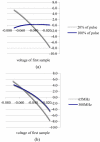FPGA-Based Pulse Pile-Up Correction With Energy and Timing Recovery
- PMID: 24265508
- PMCID: PMC3833626
- DOI: 10.1109/TNS.2012.2207403
FPGA-Based Pulse Pile-Up Correction With Energy and Timing Recovery
Abstract
Modern field programmable gate arrays (FPGAs) are capable of performing complex discrete signal processing algorithms with clock rates well above 100 MHz. This, combined with FPGA's low expense, ease of use, and selected dedicated hardware make them an ideal technology for a data acquisition system for a positron emission tomography (PET) scanner. The University of Washington is producing a high-resolution, small-animal PET scanner that utilizes FPGAs as the core of the front-end electronics. For this scanner, functions that are typically performed in dedicated circuits, or offline, are being migrated to the FPGA. This will not only simplify the electronics, but the features of modern FPGAs can be utilized to add significant signal processing power to produce higher quality images. In this paper we report on an all-digital pulse pile-up correction algorithm that has been developed for the FPGA. The pile-up mitigation algorithm will allow the scanner to run at higher count rates without incurring large data losses due to the overlapping of scintillation signals. This correction technique utilizes a reference pulse to extract timing and energy information for most pile-up events. Using pulses acquired from a Zecotech Photonics MAPD-N with an LFS-3 scintillator, we show that good timing and energy information can be achieved in the presence of pile-up utilizing a moderate amount of FPGA resources.
Keywords: Digital signal processing; field programmable gate arrays; imaging; integrated circuits; nuclear medicine; parameter estimation; positron emission tomography; signal analysis; time of arrival estimation.
Figures












References
-
- Lewellen TK, Janes M, Miyaoka RS, Gillespie SB, Park B, Lee KS, Kinahan P. System integration of the MiCES small animal PET scanner; IEEE Nuclear Science Symp. Conf. Record; 2004.pp. 3316–3320.
Grants and funding
LinkOut - more resources
Full Text Sources
Other Literature Sources
